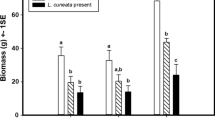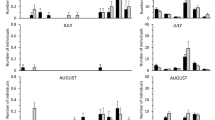Abstract
Recently, strong top-down (consumer) control of cordgrass (Spartina alterniflora) has been demonstrated. Here, we manipulated the densities of cordgrass consumers, acridid grasshoppers (Melanoplus bivittatus and Melanoplus femurrubrum), to examine their impact on cordgrass in the Plum Island Estuary (PIE), MA, USA. After 1 month, there was no detectable effect of grasshopper density on S. alterniflora biomass and grasshoppers at the highest densities (34 individuals per square meter) consumed only ~14% of the standing stock biomass. However, significant impacts of grasshopper density on grazing damage were seen. For example, plant damage and scarring length increased by 160% and 6,156%, respectively, at the highest grasshopper densities relative to exclusion (zero grasshoppers) densities. Plant height was significantly reduced with increasing grasshopper densities, although this may be a function of leaf tip removal instead of reduced plant growth. No other strong consumers of cordgrass (e.g., Littoraria irrorata, Prokelisia marginata) were observed in PIE and we suggest that consumer regulation of cordgrass is weak in this system.



Similar content being viewed by others
References
Baldwin, I.T. 1998. Jasmonate-induced responses are costly but benefit plants under attack in native populations. Proceedings of the National Academy of Sciences of the United States of America 95: 8113–8118. doi:10.1073/pnas.95.14.8113.
Barimo, J.F., and D.R. Young. 2002. Grasshopper (Orthoptera: Acrididae)–plant–environmental interactions in relation to zonation on an Atlantic Coast barrier island. Environmental Entomology 31: 1158–1167.
Beckerman, A.P. 2002. The distribution of Melanoplus femurrubrum: fear and freezing in Connecticut. Oikos 99: 131–140. doi:10.1034/j.1600-0706.2002.990113.x.
Belovsky, G.E., and J.B. Slade. 1995. Dynamics of some Montana grasshopper populations: relationships among weather, food abundance and intraspecific competition. Oecologia 101: 383–396. doi:10.1007/BF00328826.
Belovsky, G.E., and J.B. Slade. 2000. Insect herbivory accelerates nutrient cycling and increases plant production. Proceedings of the National Academy of Sciences of the United States of America 97: 14412–14417. doi:10.1073/pnas.250483797.
Bertness, M.D., and S.W. Shumway. 1992. Consumer driven pollen limitation of seed production in marsh grasses. American Journal of Botany 79: 288–293. doi:10.2307/2445017.
Bertness, M.D., C. Crain, C. Holdredge, and N. Sala. 2008. Eutrophication and consumer control of New England salt marsh primary productivity. Conservation Biology 22: 131–139. doi:10.1111/j.1523-1739.2007.00801.x.
Cebrian, J., and J. Lartigue. 2004. Patterns of herbivory and decomposition in aquatic and terrestrial ecosystems. Ecological Monographs 74: 237–259. doi:10.1890/03-4019.
Chase, J.M. 1996. Varying resource abundances and competitive dynamics. American Naturalist 147: 649–654. doi:10.1086/285871.
Daehler, C.C., and D.R. Strong. 1995. Impact of high herbivore densities on introduced smooth cordgrass, Spartina alterniflora, invading San Francisco Bay, California. Estuaries 18: 409–417. doi:10.2307/1352323.
Daehler, C.C., and D.R. Strong. 1997. Reduced herbivory resistance in introduced smooth cordgrass (Spartina alterniflora) after a century of herbivory-free growth. Oecologia 110: 99–108. doi:10.1007/s004420050138.
Davis, L.V., and I.E. Gray. 1966. Zonal and seasonal distribution of insects in North Carolina salt marshes. Ecological Monographs 36: 275–295. doi:10.2307/1942419.
Deegan, L.A., J.L. Bowen, D. Drake, J.W. Fleeger, C.T. Friedrichs, K.A. Galván, J.E. Hobbie, C. Hopkinson, J.M. Johnson, D.S. Johnson, L.E. Lemay, E. Miller, B.J. Peterson, C. Picard, S. Sheldon, J. Vallino, and R.S. Warren. 2007. Susceptibility of salt marshes to nutrient enrichment and predator removal. Ecological Applications 17: S42–S63. doi:10.1890/06-0452.1.
Denno, R.F., C. Gratton, M.A. Peterson, G.A. Langellotto, D.L. Finke, and A.F. Huberty. 2002. Bottom-up forces mediate natural-enemy impact in a phytophagous insect community. Ecology 83: 1443–1458.
Denno, R.F., C. Gratton, H. Döbel, and D.L. Finke. 2003. Predation risk affects relative strength of top-down and bottom-up impacts on insect herbivores. Ecology 84: 1032–1044. doi:10.1890/0012-9658(2003)084[1032:PRARSO]2.0.CO;2.
Drake, D.C., B.J. Peterson, L.A. Deegan, L.A. Harris, E.E. Miller, and R.S. Warren. 2008. Plant nitrogen dynamics in fertilized and natural New England salt marshes: a paired N-15 tracer study. Marine Ecology Progress Series 354: 35–46. doi:10.3354/meps07170.
Finke, D.L., and R.F. Denno. 2004. Predator diversity dampens trophic cascades. Nature 429: 407–410. doi:10.1038/nature02554.
Fleeger, J.W., D.S. Johnson, K.A. Galván, and L.A. Deegan. 2008. Top-down and bottom-up control of infauna varies across the salt marsh landscape. Journal of Experimental Marine Biology and Ecology 357: 20–34. doi:10.1016/j.jembe.2007.12.003.
Goranson, C.E., C.-K. Ho, and S.C. Pennings. 2004. Environmental gradients and herbivore feeding preferences in coastal salt marshes. Oecologia 140: 591–600. doi:10.1007/s00442-004-1615-2.
Gustafson, D.J., J. Kilheffer, and B.R. Silliman. 2006. Relative effects of Littoraria irrorata and Prokelisia marginata on Spartina alterniflora. Estuaries and Coasts 29: 639–644.
McFarlin, C.R., J.S. Brewer, T.L. Buck, and S.C. Pennings. 2008. Impact of fertilization on a salt marsh food web in Georgia. Estuaries and Coasts 31: 313–325.
McGoff, N.M. 2004. The influence of the marsh grasshopper, Orchelimum fidicinium on nutrient cycling and productivity of Spartina alterniflora in a salt marsh environment. M.S. Thesis, University of Virginia, Charlottesville, Virginia.
Mendelssohn, I.A., and J.T. Morris. 2000. Ecophysiological controls on the growth of Spartina alterniflora. In Concepts and controversies in tidal marsh ecology, eds. M. P. Weinstein, and D. A. Kreeger, 59–80. Dordrecht: Kluwer.
Mitsch, W.J., and J.G. Gosselink. 2000. Wetlands. 4New York: Van Nostrand Reinhold.
Odum, E.P., and A. del la Cruz. 1967. Estuaries 383–385. ed. G.H. Lauff. Am. Assoc. Adv. Sci. Publ. 83.
Onsager, J.A., and J.E. Henry. 1977. A method for estimating the density of rangeland grasshoppers (Orthoptera: Acrididae) in experimental plots. Acrida 6: 231–237.
Pennings, S.C., and M.D. Bertness. 2001. Salt marsh communities. In Marine community ecology, eds. M. D. Bertness, , S. D. Gaines, and M. E. Hay, 289–316. Sunderland: Sinauer.
Pennings, S.C., and B.R. Silliman. 2005. Linking biogeography and community ecology: latitudinal variation in plant-herbivore interaction strength. Ecology 86: 2310–2319. doi:10.1890/04-1022.
Pennings, S.C., E.L. Siska, and M.D. Bertness. 2001. Latitudinal differences in plant palatability in Atlantic Coast salt marshes. Ecology 82: 1344–1359.
Pennings, S.C., M. Zimmer, N. Dias, M. Sprung, N. Dave, C.-K. Ho, A. Kunza, C. McFarlin, M. Mews, A. Pfauder, and C. Salgado. 2007. Latitudinal variation in plant–herbivore interactions in European salt marshes. Oikos 116: 543–549.
Porter, E.E., R.A. Redak, and H.E. Braker. 1996. Density, biomass, and diversity of grasshoppers (Orthoptera: Acrididae) in a California native grassland. Great Basin Naturalist 56: 172–176.
Schmitz, O.J., A.P. Beckerman, and K. O’Brien. 1997. Behaviorally-mediated trophic cascades: effects of predation risk on food web interactions. Ecology 78: 1388–1399.
Silliman, B.R., and M.D. Bertness. 2002. A trophic cascade regulates salt marsh primary production. Proceedings of the National Academy of Sciences 99: 10500–10505. doi:10.1073/pnas.162366599.
Silliman, B.R., and A. Bortolus. 2003. Underestimation of Spartina production in western Atlantic salt marshes: marsh invertebrates eat more than just detritus. Oikos 101: 549–555. doi:10.1034/j.1600-0706.2003.12070.x.
Silliman, B.R., and J.C. Zieman. 2001. Top-down control of Spartina alterniflora growth by periwinkle grazing in a Virginia salt marsh. Ecology 82: 2830–2845.
Siska, E.L., S.C. Pennings, T.L. Buck, and M.D. Hanisak. 2002. Latitudinal variation in palatability of salt marsh plants: which traits are responsible? Ecology 83: 3369–3381.
Smalley, A.E. 1960. Energy flow of a salt marsh grasshopper population. Ecology 41: 672–677. doi:10.2307/1931800.
Smith, T.J. III, and W.E. Odum. 1981. The effects of grazing by snow geese on coastal salt marshes. Ecology 62: 98–106.
Strauss, S.Y., J.A. Rudgers, J.A. Lau, and R.E. Irwin. 2002. Direct and ecological costs of resistance to herbivory. Trends in Ecology and Evolution 17: 278–285. doi:10.1016/S0169-5347(02)02483-7.
Teal, J.M. 1962. Energy flow in the salt marsh ecosystem of Georgia. Ecology 43: 614–624.
Toth, G.B., M. Karlsson, and H. Pavia. 2007. Mesoherbivores reduce net growth and induce chemical resistance in natural seaweed populations. Oecologia 152: 245–255. doi:10.1007/s00442-006-0643-5.
Tyrell, M.C., M. Dionne, and J.A. Edgerly. 2008. Physical factors mediate effects of grazing by a non-indigenous snail species on salt marsh cordgrass (Spartina alterniflora) in New England marshes. ICES Journal of Marine Science 65: 746–752.
Valiela, I. 1995. Marine ecological processes. 2New York: Springer.
Vince, S.W., I. Valiela, and J.M. Teal. 1981. An experimental study of the structure of herbivorous insect communities in a salt marsh. Ecology 62: 1662–1678. doi:10.2307/1941520.
Wason, E.L., and S. Pennings. 2008. Grasshopper (Orthoptera: Tettigoniidae) species composition and size across latitude in Atlantic coast salt marshes. Estuaries and Coasts 31: 335–343.
Acknowledgements
We thank C. Kennedy and C. E. Goranson for field assistance. J.W. Fleeger, M.A. Grippo, K.A. Galván, R. S. Warren, and three anonymous reviewers provided helpful manuscript comments. This work was supported in part by the National Science Foundation under Grants No. 0213767 and 9726921.
Author information
Authors and Affiliations
Corresponding author
Rights and permissions
About this article
Cite this article
Johnson, D.S., Jessen, B.J. Do Spur-Throated Grasshoppers, Melanoplus spp. (Orthoptera: Acrididae), Exert Top-Down Control on Smooth Cordgrass Spartina alterniflora in Northern New England?. Estuaries and Coasts 31, 912–919 (2008). https://doi.org/10.1007/s12237-008-9074-3
Received:
Revised:
Accepted:
Published:
Issue Date:
DOI: https://doi.org/10.1007/s12237-008-9074-3




